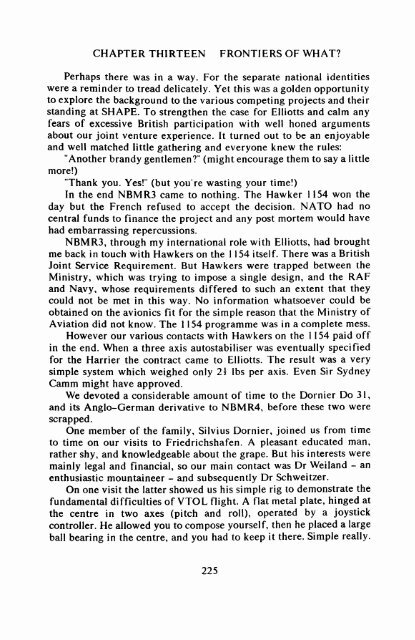COMBAT AND COMPETITION.pdf - Lakes Gliding Club
COMBAT AND COMPETITION.pdf - Lakes Gliding Club
COMBAT AND COMPETITION.pdf - Lakes Gliding Club
You also want an ePaper? Increase the reach of your titles
YUMPU automatically turns print PDFs into web optimized ePapers that Google loves.
CHAPTER THIRTEEN FRONTIERS OF WHAT?<br />
Perhaps there was in a way. For the separate national identities<br />
were a reminder to tread delicately. Yet this was a golden opportunity<br />
to explore the background to the various competing projects and their<br />
standing at SHAPE. To strengthen the case for Elliotts and calm any<br />
fears of excessive British participation with well honed arguments<br />
about our joint venture experience. It turned out to be an enjoyable<br />
and well matched little gathering and everyone knew the rules:<br />
"Another brandy gentlemen?" (might encourage them to say a little<br />
more!)<br />
"Thank you. Yes!" (but you're wasting your time!)<br />
In the end NBMR3 came to nothing. The Hawker 1154 won the<br />
day but the French refused to accept the decision. NATO had no<br />
central funds to finance the project and any post mortem would have<br />
had embarrassing repercussions.<br />
NBMR3, through my international role with Elliotts, had brought<br />
me back in touch with Hawkers on the 1 154 itself. There was a British<br />
Joint Service Requirement. But Hawkers were trapped between the<br />
Ministry, which was trying to impose a single design, and the RAF<br />
and Navy, whose requirements differed to such an extent that they<br />
could not be met in this way. No information whatsoever could be<br />
obtained on the avionics fit for the simple reason that the Ministry of<br />
Aviation did not know. The 1154 programme was in a complete mess.<br />
However our various contacts with Hawkers on the 1154 paid off<br />
in the end. When a three axis autostabiliser was eventually specified<br />
for the Harrier the contract came to Elliotts. The result was a very<br />
simple system which weighed only 2\ Ibs per axis. Even Sir Sydney<br />
Camm might have approved.<br />
We devoted a considerable amount of time to the Dornier Do 31,<br />
and its Anglo-German derivative to NBMR4, before these two were<br />
scrapped.<br />
One member of the family, Silvius Dornier, joined us from time<br />
to time on our visits to Friedrichshafen. A pleasant educated man,<br />
rather shy, and knowledgeable about the grape. But his interests were<br />
mainly legal and financial, so our main contact was Dr Weiland - an<br />
enthusiastic mountaineer - and subsequently Dr Schweitzer.<br />
On one visit the latter showed us his simple rig to demonstrate the<br />
fundamental difficulties of VTOL flight. A flat metal plate, hinged at<br />
the centre in two axes (pitch and roll), operated by a joystick<br />
controller. He allowed you to compose yourself, then he placed a large<br />
ball bearing in the centre, and you had to keep it there. Simple really.<br />
225

















